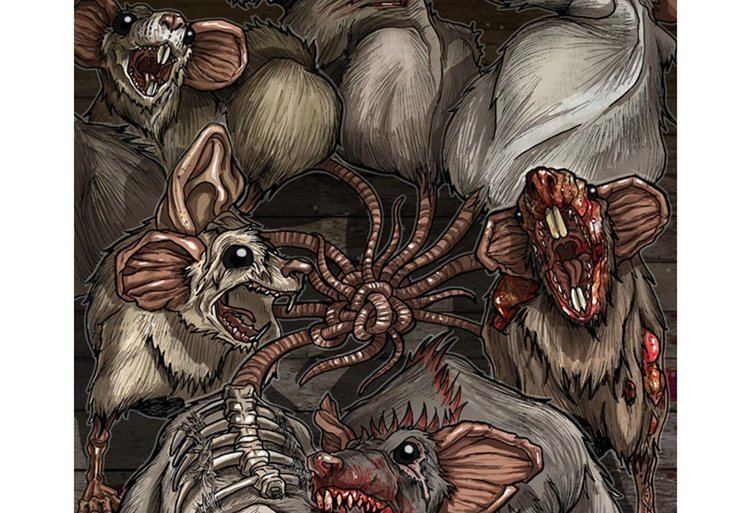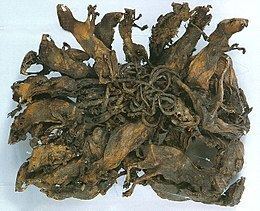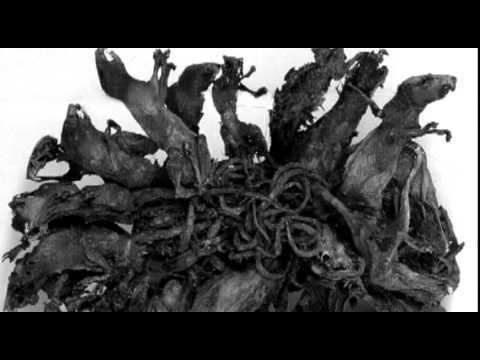 | ||
Tiniest rat king
A rat king is a term for a number of rats whose tails are intertwined and bound together by one of several possible mechanisms, such as entangling material like hair or sticky substances like sap or gum. The number of rats joined together varies from a few to as many as 30. Historically, the phenomenon is particularly associated with Germany, which produced many reported instances. Rat kings occur so rarely that they have sometimes been thought to be cryptids, but there are several well-attested modern occurrences. A similar phenomenon happens with other small rodents such as forest mice and squirrels.
Contents

In folklore, rat kings are associated with various superstitions and were often seen as a bad omen, particularly associated with plague..

The rat king
Origin of the name

The original German term, Rattenkönig, was calqued into English as rat king, and into French as roi des rats. The term was not originally used in reference to actual rats, but for persons who lived off others. Konrad Gesner in Historia animalium (1551–58) stated: "Some would have it that the rat waxes mighty in its old age and is fed by its young: this is called the rat king." Martin Luther stated: "finally, there is the Pope, the king of rats right at the top." Later, the term referred to a king sitting on a throne of knotted tails.
An alternative theory states that the name in French was rouet de rats (or a spinning wheel of rats, the knotted tails being wheel spokes), with the term transforming over time into roi de rats.
History
The earliest report of rat kings comes from 1564. The phenomenon may have diminished when the brown rat (Rattus norvegicus) displaced the black rat (R. rattus) in the 18th century. Most extant examples are formed from black rats.
The only find involving sawah rats (R. rattus brevicaudatus) occurred on March 23, 1918, in Bogor on Java, where a rat king of ten young field rats was found. Similar attachments have been reported in other species: in April 1929, a group of young forest mice (Apodemus sylvaticus) was reported in Holstein, Germany; and in June 2013 a "squirrel king" of six living squirrels stuck together with pine sap was found in Regina, Saskatchewan, and the animals were separated by veterinarians.
Specimens of purported rat kings are kept in some museums. The museum Mauritianum in Altenburg (Thuringia) shows the largest well-known mummified "rat king", which was found in 1828 in a miller's fireplace at Buchheim. It consists of 32 rats. Alcohol-preserved rat kings are shown in museums in Hamburg, Göttingen, Hamelin, and Stuttgart. The Tartu Ülikooli Zooloogiamuuseum (Museum of Zoology in Tartu, Estonia) has a specimen. A rat king found in 1930 in New Zealand, displayed in the Otago Museum in Dunedin, was composed of immature black rats whose tails were entangled by horse hair.
A rat king discovered in 1963 by a farmer named P. van Nijnatten at Rucphen, Netherlands, as published by cryptozoologist M. Schneider, consists of seven rats. X-ray images show formations of callus at the fractures of their tails, which suggests that the animals survived for an extended period of time with their tails tangled.
Sightings have been sporadic in recent years. One 2005 sighting comes from an Estonian farmer in the Võrumaa region.
All told, relatively few rat kings have been discovered; depending on the source, the number of reported instances varies between 35 and 50 finds.
In folklore and popular culture
Historically, the rat king was viewed as a bad omen, most likely due to rats being considered carriers for diseases such as the plague.
Rat kings appear in novels such as The Tale of One Bad Rat by Bryan Talbot, Ratking by Michael Dibdin, Peeps by Scott Westerfeld, The Haunting of Alaizabel Cray by Chris Wooding, Rats and Gargoyles by Mary Gentle, Luther: The Calling by Neil Cross, The War for the Lot by Sterling E. Lanier, and The Rats by James Herbert. The Lorrie Moore short story Wings features a couple who discover a rat king in their attic. In Alan Moore and Ian Gibson's comic book series The Ballad of Halo Jones, the Rat King was a weapon of war, a super-intelligent collective of five rats with entwined tails who were able to communicate via a computer terminal.
In The Amazing Maurice and his Educated Rodents by Terry Pratchett, Keith skeptically notes that the filth associated with supposedly tying the young rats together at a young age is not found in a rat's nest, and suspects that a rat king is created as a sort of project by a rat catcher himself. One rat king, called Spider due to having eight component rats, supports this by his grudge against humanity for his traumatic creation. In an author's note at the end of the novel, Pratchett ventures the theory that "down the ages some cruel and inventive people have had altogether too much time on their hands".
E. T. A. Hoffmann's The Nutcracker and the Mouse King features a "Mouse King" (Mausekönig) with multiple heads, seemingly inspired by the multiple-bodied rat king. The character is typically not depicted as multi-headed in productions of the Tchaikovsky ballet The Nutcracker, based on the novella.
The sixth episode of the first season of 30 Rock, "Jack Meets Dennis," Dennis Duffy claims to have seen a rat king. Later, Liz Lemon describes what her future with Dennis would be like, becoming "more and more tangled up in each other's lives until [she] can't even get away," and realizes that he is a metaphorical rat king.
The contemporary German artist Katharina Fritsch created Rattenkönig, a large rat king sculpture in plaster in 1993 that was included in the Venice Biennale in 1999.
